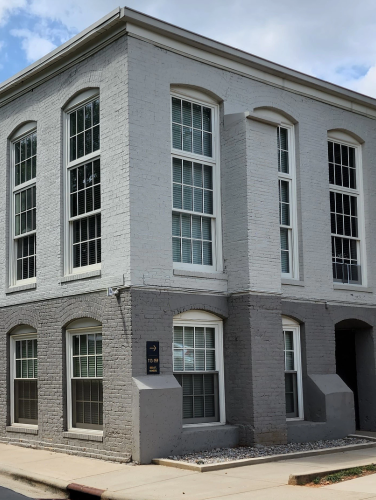
Highland Park Mill #3
(ca. 1904)
Upon its completion, Highland Park Mill #3 was one of Charlotte’s largest and most technologically advanced cotton mills.
2901 - 2911 N. Davidson St., Charlotte, NC 28205
When completed in 1904, Highland Park Manufacturing Company Mill #3 was by far one of the largest mills in the area. Along with Hoskins Mill and neighboring Mecklenburg Mill, both completed in 1904 as well, Highland Park Mill #3 was also one of the last cotton mills to be built in or near Charlotte, and one of the last to close, in 1969. The first Highland Park Mill, completed in 1892 on North Brevard Street at 12th Street near uptown Charlotte, included among its investors Daniel Augustus Tompkins (1851-1914), a South Carolina native who became a driving force in the southern textile industry. His D. A. Tompkins Company engineering firm helped build at least 250 cotton oil mills, 150 electric plants, and 100 cotton mills, including Highland Park Mill #1. The Highland Park Manufacturing Company expanded in 1898 with the acquisition of the former Standard Mills in Rock Hill, South Carolina. Shareholders decided to add a newer and larger third mill in early 1903.
Property Quick Links
Constructed at an estimated cost of $500,000 about one mile north of Highland Mill #1, the company selected Stuart W. Cramer, a former engineer with Tompkins’ firm before going into business for himself designing and equipping cotton mills, to design its third mill. Highland Mill #3 became one of the South's best known mills, as it was prominently and extensively featured throughout Cramer’s influential book Useful Information for Cotton Manufacturers Volume 3 (1906). Fifty percent larger than Charlotte’s second largest Louise Mill, Highland Mill #3 had 30,000 spindles, 1,000 looms, over 800 employees, and a $100,000 power generating plant on Sugar Creek that made Highland Mills Nos. 1 and 3 North Carolina’s first electrically driven mills. The new mill made Highland Park Manufacturing Company the area’s largest cotton manufacturing firm (and the nation’s third-largest gingham producer) until the 1908 creation of the Chadwick-Hoskins Company through the merger of five smaller companies. The new mill also spawned the establishment of an entire community that came to be known as North Charlotte. Originally eighty mill houses – white frame dwellings in several blocks of neat rows adjacent to the mill – were built. More were added later. North Charlotte thrived as a self-contained community for many years, and included a hotel, a mercantile business with multiple stores and lodge rooms, and drug and grocery stores.
In 1906, Charles Worth Johnston, who had been with Highland Park Manufacturing since 1892, became the company’s president and launched an aggressive expansion program of acquisitions and consolidations to build what was known as the Johnston chain. Beginning with the acquisition of Anchor Mills, thirteen mills throughout the Carolinas eventually came under Johnston ownership, including the newly built Johnston Manufacturing Company of 1913, all headquartered in the fifteen-story Johnston Building (1924) on South Tryon Street. Upon Johnston’s 1938 retirement, the company was headed by his son R. Horace Johnston until the early 1950s. By the mid-1960s, the domestic textile industry had begun to wane, prompting the dissolution of the Highland Park Manufacturing Company and the cessation of textile manufacturing at Mill #3 in 1969.

